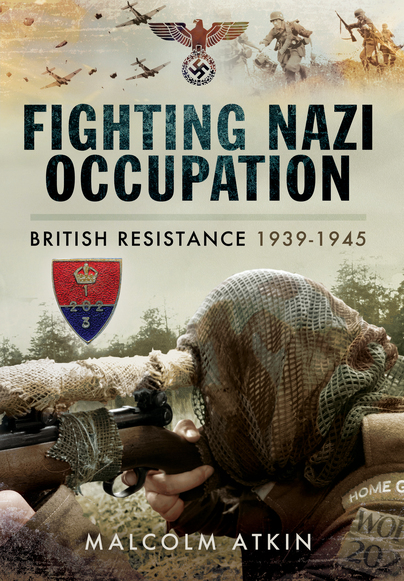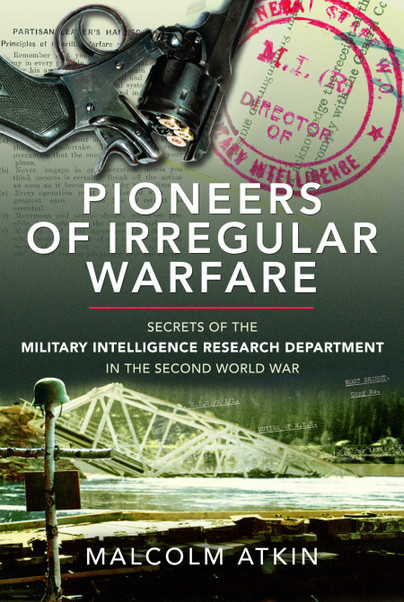Author Malcolm Atkin

I am currently reading a bunch of Malcolm Atkin books on the SOE, Section D and other secret organisations of WW2. I will have reviews coming shortly but wanted to share them all in one place as they are a great collection to have on this theme.
Section D for Destruction

When Neville Chamberlain made his famous Peace in Our Time statement in 1938, after the Munich Agreement with Hitler, he may, or may not, have been aware that the new Section D of the Secret Intelligence Service was already making plans to mount an all-out political and sabotage war against Nazi Germany. This was a new form of warfare, encompassing bribery, black propaganda and sabotage by agents described as having no morals or scruples.
To the horror of many, it disregarded the conventions of neutrality and was prepared to hit the Nazi state wherever it could do most damage. Malcolm Atkin reveals how Section Ds struggle to build a European wide anti-Nazi resistance movement was met with widespread suspicion from government, to the extent of a systematic destruction of its reputation.
It was, however, a key pioneer of irregular warfare that led to the formation of the famous Special Operations Executive (SOE). His study is the first in-depth account of it to be published since the release of previously secret documents to the National Archives.
Fighting Nazi Occupation

A major reassessment of the plans to organise guerrilla warfare and longer-term resistance in the case of a Nazi invasion of Britain. It tells the story of competition by the Secret Intelligence Service (M16) and War Office to organise irregular warfare in the country and the result is a new vision of the murky and machiavellian world of wartime British intelligence.
The study includes new insights into the, much misunderstood, War Office Auxiliary Units and the wider role of the Home Guard in secret warfare. This is also the first substantial publication of one of the Second World War’s last, and best-kept, secrets – the existence of an ultra-secret resistance network organised by SIS and continuing in operation for most of the war.
Malcolm Atkin’s conclusions will cause controversy among military historians and will change our understanding of preparations made in Britain for Nazi occupation in the Second World War.
To the Last Man

The Home Guard was formed in 1940 to fight an uncompromising and essentially suicidal campaign that was to buy a few hours grace for the regular forces to re-group after a German invasion. But the Dad’s Army TV series has led to a serious distortion in the perception of the Home Guard and, as Malcolm Atkin reveals in this thought-provoking and meticulously researched book, its image was manipulated from its earliest days.
Using official documents, contemporary histories, stories, artwork and poetry, and comparing these with post-war films and histories, he takes a unique perspective. He explores how the myths of the Home Guard arose and were exploited by official propaganda and the wartime and post-war media. He also shows how the strong sense of gallows-humour amongst its volunteers – which fits in with a long tradition of self-deprecating humour in the British army – was taken out of context and became the basis of the TV series.
To the Last Man strips back the myths and forensically analyses how the modern perception has evolved. The result is a new, gritty, sometimes shocking, appreciation of the role that the Home Guard was expected to play in the Second World War.
Pioneers of Irregular Warfare

Covert operations and ingenious weapons for irregular warfare were developed rapidly, and with great success, by the British during the Second World War, and the story of the most famous organizations involved like SOE, the SAS and Section D of SIS is now well known, but Military Intelligence (Research), the smallest but one of the most influential of these units is relatively unknown.
Malcolm Atkin’s intriguing and meticulously researched account describes their role at the heart of the War Office in trying to develop a ‘respectable’ arm of irregular warfare and their innovations ranging from the early Commandos, sticky bombs, limpet mines, booby traps, and even helicopters to the creation of the MI9 escape organization. They were an ‘ideas factory’ rather than an operational body but the book describes their worldwide operations including Finland, Norway, Romania, the Middle East and Central Africa.
This is also a story of conflicting personalities between Jo Holland, the visionary but self-effacing head of MI(R) and his ambitious deputy, Colin Gubbins (later head of SOE), and the latter’s private war with SIS.
Also check out Malcolm’s Website too, there is a bunch of good stuff over there too.
< BACK